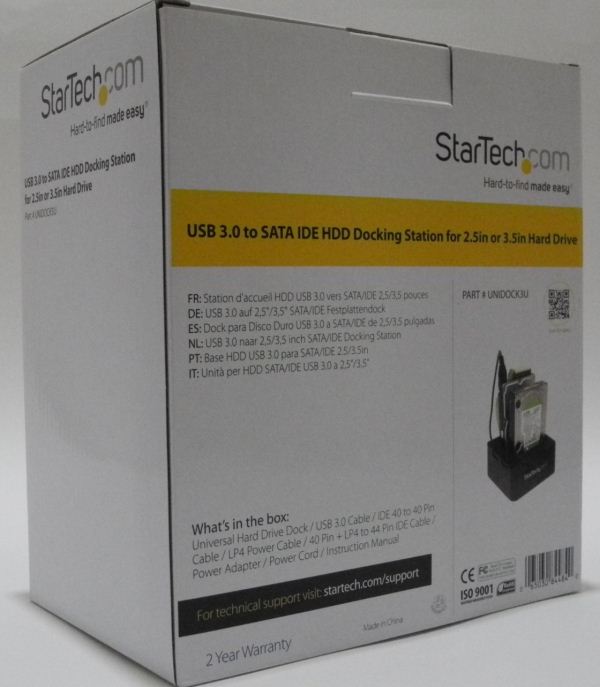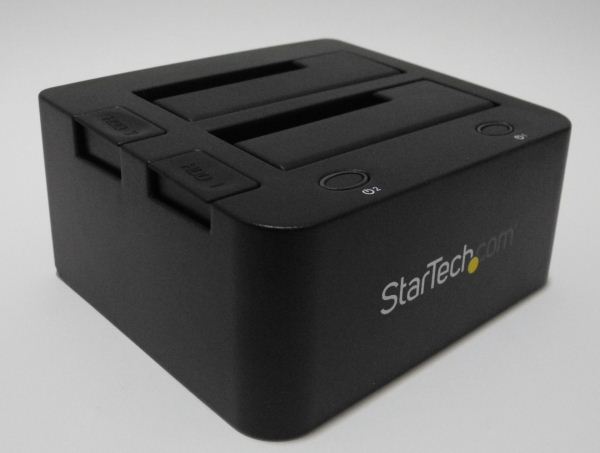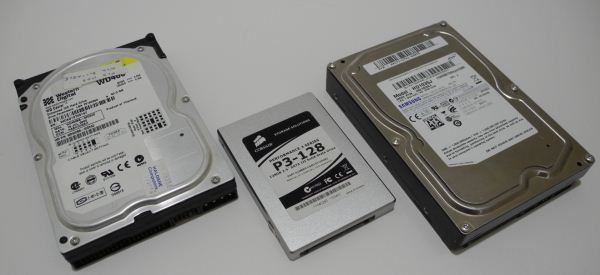StarTech.com USB 3.0 to SATA IDE HDD Docking Station Review
by Ganesh T S on June 18, 2012 1:30 PM ESTStarTech.com specializes in gadgets performing niche, yet handy functions. We reviewed their portable SATA duplicator last year, and this time around we have another interesting gadget from their stables. SATA and IDE hard drive docks / enclosures are a dime a dozen. However, the combination of features provided by the StarTech.com USB 3.0 SATA/IDE HDD docking station persuaded us to get a unit in-house for evaluation.
The unit supports upright docking of up to two disks (one SATA and one IDE). Both 2.5" and 3.5" drives can be used. Simultaneous access to both slots is also allowed. USB 3.0 (backward compatible with USB 2.0) is the only mode of communication between the PC and the dock.
Apart from the main unit pictured above, the package comes with the following components:
- 36W switching adapter with US power cord
- 1 x 3ft. USB 3.0 A Male to B Male cable
- 1 x IDE 40 to 40-Pin Cable (for 3.5" IDE drives)
- 1 x LP4 Power Cable (for 3.5" IDE drives)
- 1 x 40-Pin + LP4 to 44-Pin IDE Cable (for 2.5" IDE drives)
- Instruction Manual
For the purpose of testing out the unit, we used the following drives:
- Western Digital Caviar WD400 40GB IDE HD WD400BB-00DEA0
- Samsung HD103SJ 1000 GB 7200rpm SATA HD
- Corsair Performance 3 Series SATA III SSD CSSD-P3128GB2
While the WD and Corsair units were used for testing performance, the Samsung unit was used to check up on the power consumption profile of the unit under typical operating conditions. The Corsair SSD was also securely erased prior to the benchmarking in order to restore it to the optimum performance level. The IDE drive wasn't recognized with the jumper settings in Slave mode. Removing the jumper completely enabled access to the drive.
On the host side, we used our Ivy Bridge HTPC setup based on the Asus P8H77-M Pro motherboard. The H77 chipset provides native USB 3.0 and this rules out any performance limitation on the testbed side. The full specifications are provided below.
| StarTech.com USB 3.0 to SATA IDE Docking Station Testbed Setup | |
| Processor | Intel Core i7-3770K - 3.50 GHz (Turbo to 3.9 GHz) |
| Intel HD Graphics 4000 - 650 MHz (Max. Dynamic Frequency of 1150 MHz) | |
| Motherboard | Asus P8H77-M Pro uATX |
| OS Drive | Seagate Barracuda XT 2 TB |
| Secondary Drives | Kingston SSDNow V+ 128 GB SATA II SSD SNV325-S2/128GB |
| Corsair Performance 3 Series SATA III SSD CSSD-P3128GB2 | |
| Memory | G.SKILL ECO Series 4GB (2 x 2GB) SDRAM DDR3 1333 (PC3 10666) F3-10666CL7D-4GBECO CAS 9-9-9-24 |
| Case | Antec VERIS Fusion Remote Max |
| Power Supply | Antec TruePower New TP-550 550W |
| Operating System | Windows 7 Ultimate x64 SP1 |
| Display | Acer H243H |
| . | |
Note that the Asus P8H77-M Pro motherboard has USB 3.0 Boost, which can be used to improve the performance of storage devices connected to its USB 3.0 ports. In the Turbo mode, the BOT (Bulk Only Transport) protocol is used to improve performance (and is supported by all USB devices). USB 3.0 boost can also operate in UASP (USB Attached SCSCI Protocol) mode if the controller on the device side supports it. UASP allows multiple commands to be in transit between the host and the device at any given point of time.
For the purpose of our testing, we operated in default mode (without Turbo or UASP). This should give us an idea of the minimum performance level which can be obtained from the unit. However, we will also see whether Turbo or UASP mode makes any difference to the benchmark numbers.














17 Comments
View All Comments
alacard - Monday, June 18, 2012 - link
And they work well, highly recommended. (just make sure when you open the box you got a new one (no scratches), the older models have major flaws, and startech will rebox returns and send them out as new).Paul Tarnowski - Monday, June 18, 2012 - link
I'll have to look it up. I've had USB 3.0 for almost a year and I still haven't a single device for it. This one might just give me the excuse to get one.BTW, I've never heard of SCSCI. But I'm guessing from usage that it's a Type-0 Protocol, right?
Chuck_NC - Monday, June 18, 2012 - link
The single HDD version with built-in fan that I have has worked very well. It is finicky when used with a USB3.0 hub (random disconnects, noticed on large file copies), and won't pass Smart data to older SATA and eSATA ports. The adjustable fan is loud, but when dialed up to full speed, even keeps the fastest spinning drives cool (tested up to 10K drives). I have tried other units, especially some that use port multiplier technology with severely poor results. Have been very happy with this one on both USB3.0 and eSATA. The eSATA port seems to be faster on most machines that I have.Rix2357 - Tuesday, June 19, 2012 - link
Lots of these USB 3.0 to hard drive adaptors don't spin down the hard drives after inactivity. I care a lot about this because I keep mine attached to the notebook as an almost permanent storage and if they don't spin down, the hard drives get pretty hot after awhile.ganeshts - Tuesday, June 19, 2012 - link
Yes, it does! I have mentioned that in the review also.AstroGuardian - Tuesday, June 19, 2012 - link
Doesn't it have a detrimental effect on the drive life that it's positioned vertically?Especially for older IDE drives which were probably placed horizontally for most of their life time.
sheh - Tuesday, June 19, 2012 - link
I've always been uneasy about that too. Also some of these decks keep the drives in an angle, I think. I wonder not only about used drives but also new.I recall reading something about drives being designed to run when positioned straight in any orientation, but it still makes me wonder.
AssBall - Tuesday, June 19, 2012 - link
I really doubt it will make a difference. I have run drives hanging upside down off a power cable for 4 years without any issues. Run several of them sideways as well, and never could tell any difference in lifespan.Lerianis - Tuesday, June 19, 2012 - link
That is an old-wives tale. Modern hard drives (last 10 years) are meant to be able to run fine when mounted in any way. Stood up, on it's side, sitting on it's top, etc.As long as the drive doesn't vibrate and move, the drive should be fine. SSD's, of course, with no moving parts, you don't even have to worry about the drive moving.
Taft12 - Tuesday, June 19, 2012 - link
Got a source for that claim? I've not heard it before and many smaller cases have hard drives mounted vertically.